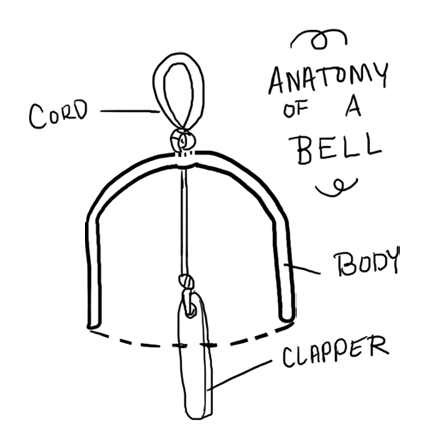The Ins and Outs of Ceramic Bells
/By Anika Major
Website: http://www.anikamajor.com
Instagram: anikamajor
I love anything that makes sound and that I can hang up in my home, so bells are definitely the noisemaker for me. They’re a fun way to experiment with claybodies, textures, and surfaces, but what is there to actually making a bell? The ideal bell is has a thin body, with an even shape, and has little to no imperfections in its shape it to produce the perfect sound.
There are a few things to consider during the building process in order to achieve a good sound and tone of the ring, and throwing would be the most ideal for uniformity, but throwing, handbuilding, or slipcasting are all viable options to make a bell! I handbuilt several different bells using a groggy midrange clay to test their sounds.
First off, what are all the parts to a bell? Here’s the breakdown:
There’s the body, the clapper, and the cord holding it all together. The clay body that you make your bell out of is an important choice. The purer the clay, the better the sound it makes - for a stronger ring, select a finer porcelain body or an earthenware without grog.
The thickness of the bell body will also affect the sound. A thicker body gives a deeper ring, and a thinner body will create a higher sound. Be careful about thin body forms, because they’re not as strong and are prone to chipping or breaking. Drastic height and width contrast will also change the sound; for a better sound, you want a more proportional bell.
The clapper can be a variety of shapes and lengths too, but the sound it produces is dependent on where it hangs inside the body. The closer it is to the opening of the bell, the better the sound! The clapper can be made from wood, ceramic, and metal, but consider its shape and how the clapper will move with the wind. If the bell is too wide, the clapper won’t reach the sides, and the clapper is too heavy, it won’t be moved by the wind. It’s helpful to make several different bodies and clappers, and mix and match when piecing them together. If hanging the bell outdoors, try to look for materials that will be able to withstand water and sun to string up your bell.
Three good cord materials for stringing up your bell are: fishing line, baling wire, and jewelry wire. These will be sturdy and offer weather resistance from sun and rain over time. I strung mine with 20 gauge fishing line, and used picture wire wrapped in loops for the hangers.
I made a variety of bells with different shapes and sizes, and strung them together with different materials to test the sounds. I made a wooden clapper, a ceramic clapper, and a metal one. Here’s a video of three of them for a sound comparison!
The bell with the wooden clapper and the metal clapper made the most even sounds, and the ceramic clapper made the harshest. Ceramic hitting ceramic also made me very nervous that it would break! Not a great thing for a potter. When I try building them again, I will most likely throw them with a grogless stoneware or porcelain for more uniformity.
Anika Major is a Texas-born artist living and working in Seattle, WA. She is currently a studio assistant to Deborah Schwartzkopf and teaching classes at Rat City Studios and Moshier Community Center. She received her BFA in 2018 from the University of North Texas in Ceramics and Painting. Her functional handbuilt forms and painterly surface designs are figurative in focus and emphasize soft, intimate, and domestic subject matter.













